Recent Advances in Conjugated Polymer-Based Microwave Absorbing Materials
Abstract
:1. Introduction
2. Theory of Microwave Absorption
3. Pure CPs as MAMs
4. CP-Based Composites as MAMs
4.1. Magnetic Ferrites/CP Composites
4.2. Magnetic Metal/CP Composites
4.3. Transition Metal Oxide/CP Composites
4.4. Carbon/CP Composites
4.5. Multi-Compound CP-Based Composites
4.6. Multi-Layer CP-Based Composites
5. Comparison of Different CP-Based MAMs
6. Conclusions and Outlook
Acknowledgments
Conflicts of Interest
References
- Zhang, Y.; Huang, Y.; Zhang, T.F.; Chang, H.C.; Xiao, P.S.; Chen, H.H.; Huang, Z.Y.; Chen, Y.S. Broadband and tunable high-performance microwave absorption of an ultralight and highly compressible graphene foam. Adv. Mater. 2015, 27, 2049–2053. [Google Scholar] [CrossRef] [PubMed]
- Lu, M.M.; Cao, M.S.; Chen, Y.H.; Cao, W.Q.; Liu, J.; Shi, H.L.; Zhang, D.Q.; Wang, W.Z.; Yuan, J. Multiscale assembly of grape-like ferroferric oxide and carbon nanotubes: A smart absorber prototype varying temperature to tune intensities. ACS Appl. Mater. Interfaces 2015, 7, 19408–19415. [Google Scholar] [CrossRef] [PubMed]
- Sun, H.; Che, R.C.; You, X.; Jiang, Y.S.; Yang, Z.B.; Deng, J.; Qiu, L.B.; Peng, H.S. Cross-stacking aligned carbon-nanotube films to tune microwave absorption frequencies and increase absorption intensities. Adv. Mater. 2014, 26, 8120–8125. [Google Scholar] [CrossRef] [PubMed]
- Qiang, R.; Du, Y.C.; Zhao, H.T.; Wang, Y.; Tian, C.H.; Li, Z.G.; Han, X.J.; Xu, P. Metal organic framework-derived Fe/C nanocubes toward efficient microwave absorption. J. Mater. Chem. A 2015, 3, 13426–13434. [Google Scholar] [CrossRef]
- Chung, D.D.L. Electromagnetic interference shielding effectiveness of carbon materials. Carbon 2001, 39, 279–285. [Google Scholar] [CrossRef]
- Tong, X.C. Advanced Materials and Design for Electromagnetic Interference; Taylor & Francis: Boca Raton, FL, USA, 2009. [Google Scholar]
- Qin, F.; Brosseau, C. A review and analysis of microwave absorption in polymer composites filled with carbonaceous particles. J. Appl. Phys. 2012, 111, 061301. [Google Scholar] [CrossRef]
- Zhang, X.J.; Wang, G.S.; Cao, W.Q.; Wei, Y.Z.; Liang, J.F.; Guo, L.; Cao, M.S. Enhanced microwave absorption property of reduced graphene oxide (RGO)-MnFe2O4 nanocomposites and polyvinylidene fluoride. ACS Appl. Mater. Interfaces 2014, 6, 7471–7478. [Google Scholar] [CrossRef] [PubMed]
- Zhang, Y.; Huang, Y.; Chen, H.H.; Huang, Z.Y.; Yang, Y.; Xiao, P.S.; Zhou, Y.; Chen, Y.S. Composition and structure control of ultralight graphene foam for high-performance microwave absorption. Carbon 2016, 105, 438–447. [Google Scholar] [CrossRef]
- Li, X.H.; Feng, J.; Du, Y.P.; Bai, J.T.; Fan, H.M.; Zhang, H.L.; Peng, Y.; Li, F.S. One-pot synthesis of CoFe2O4/graphene oxide hybrids and their conversion into FeCo/graphene hybrids for lightweight and highly efficient microwave absorber. J. Mater. Chem. A 2015, 3, 5535–5546. [Google Scholar] [CrossRef]
- Sun, G.; Dong, B.; Cao, M.; Wei, B.; Hu, C. Hierarchical dendrite-like magnetic materials of Fe3O4, γ-Fe2O3, and Fe with high performance of microwave absorption. Chem. Mater. 2011, 23, 1587–1593. [Google Scholar] [CrossRef]
- Wen, S.L.; Liu, Y.; Zhao, X.C.; Cheng, J.W.; Li, H. Synthesis, dual-nonlinear magnetic resonance and microwave absorption properties of nanosheet hierarchical cobalt particles. Phys. Chem. Chem. Phys. 2014, 16, 18333–18340. [Google Scholar] [CrossRef] [PubMed]
- Wang, C.; Han, X.J.; Xu, P.; Wang, J.Y.; Du, Y.C.; Wang, X.H.; Qin, W.; Zhang, T. Controlled synthesis of hierarchical nickel and morphology-dependent electromagnetic properties. J. Phys. Chem. C 2010, 114, 3196–3203. [Google Scholar] [CrossRef]
- Li, X.A.; Zhang, B.; Ju, C.H.; Han, X.J.; Du, Y.C.; Xu, P. Morphology-controlled synthesis and electromagnetic properties of porous fe3o4 nanostructures from iron alkoxide precursors. J. Phys. Chem. C 2011, 115, 12350–12357. [Google Scholar] [CrossRef]
- Ghasemi, A.; Hossienpour, A.; Morisako, A.; Saatchi, A.; Salehi, M. Electromagnetic properties and microwave absorbing characteristics of doped barium hexaferrite. J. Magn. Magn. Mater. 2006, 302, 429–435. [Google Scholar] [CrossRef]
- Wu, R.B.; Zhou, K.; Yang, Z.H.; Qian, X.K.; Wei, J.; Liu, L.; Huang, Y.Z.; Kong, L.B.; Wang, L.Y. Molten-salt-mediated synthesis of SiC nanowires for microwave absorption applications. CrystEngComm 2013, 15, 570–576. [Google Scholar] [CrossRef]
- Zhu, Y.F.; Zhang, L.; Natsuki, T.; Fu, Y.Q.; Ni, Q.Q. Facile Synthesis of BaTiO3 nanotubes and their microwave absorption properties. ACS Appl. Mater. Interfaces 2012, 4, 2101–2106. [Google Scholar] [CrossRef] [PubMed]
- Wang, Y.; Du, Y.C.; Qiang, R.; Tian, C.H.; Xu, P.; Han, X.J. Interfacially engineered sandwich-like rGO/carbon microspheres/rGO composite as an efficient and durable microwave absorber. Adv. Mater. Interfaces 2016, 3, 1500684. [Google Scholar] [CrossRef]
- Zhuo, R.F.; Qiao, L.; Feng, H.T.; Chen, J.T.; Yan, D.; Wu, Z.G.; Yan, P.X. Microwave absorption properties and the isotropic antenna mechanism of ZnO nanotrees. J. Appl. Phys. 2008, 104, 094101. [Google Scholar] [CrossRef]
- Burroughes, J.H.; Bradley, D.D.C.; Brown, A.R.; Marks, R.N.; Mackay, K.; Friend, R.H.; Burns, P.L.; Holmes, A.B. Light-emitting diodes based on conjugated polymers. Nature 1990, 347, 539–541. [Google Scholar] [CrossRef]
- Grimsdale, A.C.; Chan, K.L.; Martin, R.E.; Jokisz, P.G.; Holmes, A.B. Synthesis of light-emitting conjugated polymers for applications in electroluminescent devices. Chem. Rev. 2009, 109, 897–1091. [Google Scholar] [CrossRef] [PubMed]
- Yip, H.L.; Jen, A.K.Y. Recent advances in solution-processed interfacial materials for efficient and stable polymer solar cells. Energy Environ. Sci. 2012, 5, 5994–6011. [Google Scholar] [CrossRef]
- Li, G.; Zhu, R.; Yang, Y. Polymer solar cells. Nat. Photonics 2012, 6, 153–161. [Google Scholar] [CrossRef]
- Allard, S.; Forster, M.; Souharce, B.; Thiem, H.; Scherf, U. Organic semiconductors for solution-processable field-effect transistors (OFETs). Angew. Chem. Int. Ed. 2008, 47, 4070–4098. [Google Scholar] [CrossRef] [PubMed]
- Wang, C.L.; Dong, H.L.; Hu, W.P.; Liu, Y.Q.; Zhu, D.B. Semiconducting π-conjugated systems in field-effect transistors: A material odyssey of organic electronics. Chem. Rev. 2011, 112, 2208–2267. [Google Scholar] [CrossRef] [PubMed]
- Guan, W.J.; Zhou, W.J.; Lu, J.; Lu, C. Luminescent films for chemo-and biosensing. Chem. Soc. Rev. 2015, 44, 6981–7009. [Google Scholar] [CrossRef] [PubMed]
- Liu, B.; Bazan, G.C. Homogeneous fluorescence-based DNA detection with water-soluble conjugated polymers. Chem. Mater. 2004, 16, 4467–4476. [Google Scholar] [CrossRef]
- Pron, A.; Rannou, P. Processible conjugated polymers: From organic semiconductors to organic metals and superconductors. Prog. Polym. Sci. 2002, 27, 135–190. [Google Scholar] [CrossRef]
- Yoshino, K.; Tabata, M.; Kaneto, K.; Ohsawa, T. Application and characteristics of conducting polymer as radiation shielding material. Jpn. J. Appl. Phys. 1985, 24, L693–L695. [Google Scholar] [CrossRef]
- Taka, T. EMI shielding measurements on poly(3-octyl thiophene) blends. Synth. Met. 1991, 41, 1177–1180. [Google Scholar] [CrossRef]
- Chandrasekhar, P.; Naishadham, K. Broadband microwave absorption and shielding properties of a poly(aniline). Synth. Met. 1999, 105, 115–120. [Google Scholar] [CrossRef]
- Tian, C.H.; Du, Y.C.; Xu, P.; Qiang, R.; Wang, Y.; Ding, D.; Xue, J.L.; Ma, J.; Zhao, H.T.; Han, X.J. Constructing uniform core–shell PPy@PANI composites with tunable shell thickness toward enhancement in microwave absorption. ACS Appl. Mater. Interfaces 2015, 7, 20090–20099. [Google Scholar] [CrossRef] [PubMed]
- Wang, Y. Microwave absorbing materials based on polyaniline composites: A review. Int. J. Mater. Res. 2014, 105, 3–12. [Google Scholar] [CrossRef]
- Pang, R.; Hu, X.J.; Zhou, S.Y.; Sun, C.H.; Yan, J.; Sun, X.M.; Xiao, S.Z.; Chen, P. Preparation of multi-shelled conductive polymer hollow microspheres by using Fe3O4 hollow spheres as sacrificial templates. Chem. Commun. 2014, 50, 12493–12496. [Google Scholar] [CrossRef] [PubMed]
- McDowell, A.J.; Hubing, T.H. Analysis and comparison of plane wave shielding effectiveness decompositions. IEEE Trans. Electromagn. C 2014, 56, 1711–1714. [Google Scholar] [CrossRef]
- Chen, N.; Mu, G.H.; Pan, X.F.; Gan, K.K.; Gu, M.Y. Microwave absorption properties of SrFe12O19/ZnFe2O4 composite powders. Mat. Sci. Eng. B Adv. 2007, 139, 256–260. [Google Scholar] [CrossRef]
- Kim, S.S.; Jo, S.B.; Gueon, K.I.; Choi, K.K.; Kim, J.M.; Churn, K.S. Complex permeability and permittivity and microwave absorption of ferrite-rubber composite at X-band frequencies. IEEE Trans. Magn. 1991, 27, 5462–5464. [Google Scholar] [CrossRef]
- Lu, M.M.; Cao, W.Q.; Shi, H.L.; Fang, X.Y.; Yang, J.; Hou, Z.L.; Jin, H.B.; Wang, W.Z.; Yuan, J.; Cao, M.S. Multi-wall carbon nanotubes decorated with ZnO nanocrystals: Mild solution-process synthesis and highly efficient microwave absorption properties at elevated temperature. J. Mater. Chem. A 2014, 2, 10540–10547. [Google Scholar] [CrossRef]
- Wen, B.; Cao, M.S.; Hou, Z.L.; Song, W.L.; Zhang, L.; Lu, M.M.; Jin, H.B.; Fang, X.Y.; Wang, W.Z.; Yuan, J. Temperature dependent microwave attenuation behavior for carbon-nanotube/silica composites. Carbon 2013, 65, 124–139. [Google Scholar] [CrossRef]
- Kittel, C. Introduction to Solid State Physics, 8th ed.; John Wiley & Sons, Inc.: New York, NY, USA, 2005. [Google Scholar]
- Ramo, S.; Whinnery, J.R.; Duzer, T.V. Fields and Waves in Communication Electronics, 3rd ed.; John Wiley & Sons, Inc.: New York, NY, USA, 1994. [Google Scholar]
- Ohlan, A.; Singh, K.; Chandra, A.; Dhawan, S.K. Microwave absorption behavior of core-shell structured poly(3,4-ethylenedioxy thiophene)-barium ferrite nanocomposites. ACS Appl. Mater. Interfaces 2010, 2, 927–933. [Google Scholar] [CrossRef] [PubMed]
- Zhao, B.; Zhao, W.Y.; Shao, G.; Fan, B.B.; Zhang, R. Morphology-control synthesis of a core-shell structured NiCu alloy with tunable electromagnetic-wave absorption capabilities. ACS Appl. Mater. Interfaces 2015, 7, 12951–12960. [Google Scholar] [CrossRef] [PubMed]
- He, S.; Lu, C.; Wang, G.S.; Wang, J.W.; Guo, H.Y.; Guo, L. Synthesis and growth mechanism of white-fungus-like nickel sulfide microspheres, and their application in polymer composites with enhanced microwave-absorption properties. ChemPlusChem 2014, 79, 569–576. [Google Scholar] [CrossRef]
- Cole, K.S.; Cole, R.H. Dispersion and absorption in dielectrics I. Alternating current characteristics. J. Chem. Phys. 1941, 9, 341–351. [Google Scholar] [CrossRef]
- Ding, D.; Wang, Y.; Li, X.D.; Qiang, R.; Xu, P.; Chu, W.L.; Han, X.J.; Du, Y.C. Rational design of core-shell Co@C microspheres for high-performance microwave absorption. Carbon 2017, 111, 722–732. [Google Scholar] [CrossRef]
- Wu, M.; Zhang, Y.D.; Hui, S.; Xiao, T.D.; Ge, S.; Hines, W.A.; Budnick, J.I.; Taylor, G.W. Microwave magnetic properties of Co50/(SiO2)50 nanoparticles. Appl. Phys. Lett. 2002, 80, 4404–4406. [Google Scholar] [CrossRef]
- Kittel, C. On the theory of ferromagnetic resonance absorption. Phys. Rev. 1948, 73, 155–161. [Google Scholar] [CrossRef]
- Lu, B.; Dong, X.L.; Huang, H.; Zhang, X.F.; Zhu, X.G.; Lei, J.P.; Sun, J.P. Microwave absorption properties of the core/shell-type iron and nickel nanoparticles. J. Magn. Magn. Mater. 2008, 320, 1106–1111. [Google Scholar] [CrossRef]
- Liao, S.B. Ferromagnetic Physics; Science Press: Beijing, China, 1992. [Google Scholar]
- Kim, S.S.; Kim, S.T.; Yoon, Y.C.; Lee, K.S. Magnetic, dielectric, and microwave absorbing properties of iron particles dispersed in rubber matrix in gigahertz frequencies. J. Appl. Phys. 2005, 97, 10F905. [Google Scholar] [CrossRef]
- Gao, B.; Qiao, L.; Wang, J.B.; Liu, Q.F.; Li, F.S.; Feng, J.; Xue, D.S. Microwave absorption properties of the Ni nanowires composite. J. Phys. D Appl. Phys. 2008, 41, 235005. [Google Scholar] [CrossRef]
- Lv, R.T.; Cao, A.Y.; Kang, F.Y.; Wang, W.X.; Wei, J.Q.; Gu, J.L.; Wang, K.L.; Wu, D.H. Single-crystalline permalloy nanowires in carbon nanotubes: Enhanced encapsulation and magnetization. J. Phys. Chem. C 2007, 111, 11475–11479. [Google Scholar] [CrossRef]
- Vinoy, K.J.; Jha, R.M. Radar Absorbing Materials: From Theory to Design and Characterization; Kluwer: Boston, MA, USA, 1996. [Google Scholar]
- Du, Y.C.; Liu, W.W.; Qiang, R.; Wang, Y.; Han, X.J.; Ma, J.; Xu, P. Shell thickness-dependent microwave absorption of core-shell Fe3O4@C composites. ACS Appl. Mater. Interfaces 2014, 6, 12997–13006. [Google Scholar] [CrossRef] [PubMed]
- Song, W.L.; Cao, M.S.; Fan, L.Z.; Lu, M.M.; Li, Y.; Wang, C.Y.; Ju, H.F. Highly ordered porous carbon/wax composites for effective electromagnetic attenuation and shielding. Carbon 2014, 77, 130–142. [Google Scholar] [CrossRef]
- Ma, Z.; Zhang, Y.; Cao, C.T.; Yuan, J.; Liu, Q.F.; Wang, J.B. Attractive microwave absorption and the impedance match effect in zinc oxide and carbonyl iron composite. Phys. B 2011, 406, 4620–4624. [Google Scholar] [CrossRef]
- Zhang, X.; Zhu, J.H.; Haldolaarachchige, N.; Ryu, J.; Young, D.P.; Wei, S.Y.; Guo, Z.H. Synthetic process engineered polyaniline nanostructures with tunable morphology and physical properties. Polymer 2012, 53, 2109–2120. [Google Scholar] [CrossRef]
- Sun, Y.Y.; Guo, G.Z.; Yang, B.H.; Zhou, X.; Cui, H.Y.; Liu, Y.Q.; Zhao, G.Z. Synthesis of polyaniline microrods with high microwave absorption behaviours. Micro Nano Lett. 2010, 5, 313–316. [Google Scholar] [CrossRef]
- Xie, A.; Wu, F.; Sun, M.X.; Dai, X.Q.; Xu, Z.H.; Qiu, Y.Y.; Wang, Y.; Wang, M.Y. Self-assembled ultralight three-dimensional polypyrrole aerogel for effective electromagnetic absorption. Appl. Phys. Lett. 2015, 106, 222902. [Google Scholar] [CrossRef]
- Wu, F.; Sun, M.X.; Jiang, W.C.; Zhang, K.; Xie, A.M.; Wang, Y.; Wang, M.Y. A self-assembly method for the fabrication of a three-dimensional (3d) polypyrrole (PPy)/poly(3,4-Ethylenedioxythiophene) (PEDOT) hybrid composite with excellent absorption performance against electromagnetic pollution. J. Mater. Chem. C 2016, 4, 82–88. [Google Scholar] [CrossRef]
- Zhang, P.; Han, X.J.; Kang, L.L.; Qiang, R.; Liu, W.W.; Du, Y.C. Synthesis and characterization of polyaniline nanoparticles with enhanced microwave absorption. RSC Adv. 2013, 3, 12694–12701. [Google Scholar] [CrossRef]
- Lee, S.P.; Chen, Y.J.; Ho, C.M.; Chang, C.P.; Hong, Y.S. A study on synthesis and characterization of the core–shell materials of Mn1−xZnxFe2O4–Polyaniline. Mater. Sci. Eng. B Adv. 2007, 143, 1–6. [Google Scholar] [CrossRef]
- Han, X.; Wang, Y.S. Studies on the synthesis and microwave absorption properties of Fe3O4/polyaniline FGM. Phys. Scr. 2007, 129, 335–339. [Google Scholar] [CrossRef]
- Wang, Z.Z.; Bi, H.; Liu, J.; Sun, T.; Wu, X.L. Magnetic and microwave absorbing properties of polyaniline/γ-Fe2O3 nanocomposite. J. Magn. Magn. Mater. 2008, 320, 2132–3139. [Google Scholar] [CrossRef]
- Yang, C.M.; Li, H.Y.; Xiong, D.B.; Cao, Z.Y. Hollow polyaniline/Fe3O4 microsphere composites: Preparation, characterization, and applications in microwave absorption. React. Funct. Polym. 2009, 69, 137–144. [Google Scholar] [CrossRef]
- Phang, S.W.; Tadokoro, M.; Watanabe, J.; Kuramoto, N. Effect of Fe3O4 and TiO2 addition on the microwave absorption property of polyaniline micro/nanocomposites. Polym. Adv. Technol. 2009, 20, 550–557. [Google Scholar] [CrossRef]
- Yang, C.H.; Du, J.J.; Peng, Q.; Qiao, R.R.; Chen, W.; Xu, C.L.; SHuai, Z.G.; Gao, M.Y. Polyaniline/Fe3O4 nanoparticle composite: Synthesis and reaction mechanism. J. Phys. Chem. B 2009, 113, 5052–5058. [Google Scholar] [CrossRef] [PubMed]
- Ma, R.T.; Zhao, H.T.; Zhang, G. Preparation, characterization and microwave absorption properties of polyaniline/Co0.5Zn0.5Fe2O4 nanocomposite. Mater. Res. Bull. 2010, 45, 1064–1068. [Google Scholar] [CrossRef]
- Gandhi, N.; Singh, K.; Ohlan, A.; Singh, D.P.; Dhawan, S.K. Thermal, dielectric and microwave absorption properties of polyaniline–CoFe2O4 nanocomposites. Compos. Sci. Technol. 2011, 71, 1754–1760. [Google Scholar] [CrossRef]
- Belaabed, B.; Wojkiewicz, J.L.; Lamouri, S.; Kamchi, N.E.; Lasri, T. Synthesis and characterization of hybrid conducting composites based on polyaniline/magnetite fillers with improved microwave absorption properties. J. Alloy. Compd. 2012, 527, 137–144. [Google Scholar] [CrossRef]
- Hosseini, S.H.; Asadnia, A. Synthesis, characterization, and microwave-absorbing properties of polypyrrole/MnFe2O4 nanocomposite. J. Nanomater. 2012, 2012, 198973. [Google Scholar] [CrossRef]
- Zhou, W.C.; Hu, X.J.; Zhou, S.Y.; Yan, J.; Sun, C.H.; Chen, P. Facile route to controlled iron oxides/poly(3,4-ethylenedioxythiophene) nanocomposites and microwave absorbing properties. Compos. Sci. Technol. 2013, 87, 14–21. [Google Scholar] [CrossRef]
- Zhu, Y.F.; Ni, Q.Q.; Fu, Y.Q.; Natsuki, T. Synthesis and microwave absorption properties of electromagnetic functionalized Fe3O4–polyaniline hollow sphere nanocomposites produced by electrostatic self-assembly. J. Nanopart. Res. 2013, 15, 1988. [Google Scholar] [CrossRef] [PubMed]
- Wang, C.P.; Shen, Y.H.; Wang, X.F.; Zhang, H.; Xie, A.J. Synthesis of novel NiZn-Ferrite/polyaniline nanocomposites and their microwave absorption properties. Mat. Sci. Semicond. Prog. 2013, 16, 77–82. [Google Scholar] [CrossRef]
- Wang, M.; Ji, G.B.; Zhang, B.S.; Tang, D.M.; Yang, Y.; Du, Y.W. Controlled synthesis and microwave absorption properties of Ni0.6Zn0.4Fe2O4/PANI composite via an in-situ polymerization process. J. Magn. Magn. Mater. 2015, 377, 52–58. [Google Scholar] [CrossRef]
- Li, Z.T.; Ye, M.Q.; Han, A.J.; Du, H. Preparation, characterization and microwave absorption properties of NiFe2O4 and its composites with conductive polymer. J. Mater. Sci. Mater. Electron. 2016, 27, 1031–1043. [Google Scholar] [CrossRef]
- Sun, Y.P.; Xiao, F.; Liu, X.G.; Feng, C.; Jin, C.G. Preparation and electromagnetic wave absorption properties of core–shell structured Fe3O4-polyaniline nanoparticles. RSC Adv. 2013, 3, 22554–22559. [Google Scholar] [CrossRef]
- Li, Y.B.; Chen, G.; Li, Q.H.; Qiu, G.Z.; Liu, X.H. Facile synthesis, magnetic and microwave absorption properties of Fe3O4/polypyrrole core/shell nanocomposite. J. Alloy Compd. 2011, 509, 4104–4107. [Google Scholar] [CrossRef]
- Nakamura, T. Snoek’s limit in high-frequency permeability of polycrystalline Ni-Zn, Mg-Zn, and Ni-Zn-Cu spinel ferrites. J. Appl. Phys. 2000, 88, 348–353. [Google Scholar] [CrossRef]
- Tong, G.X.; Wu, W.H.; Guan, J.G.; Qian, H.S.; Yuan, J.H.; Li, W. Synthesis and characterization of nanosized urchin-like α-Fe2O3 and Fe3O4: Microwave electromagnetic and absorbing properties. J. Alloy Compd. 2011, 509, 4320–4326. [Google Scholar] [CrossRef]
- Li, Q.F.; Li, Y.F.; Li, X.; Chen, S.L.; Zhang, S.D.; Wang, J.Z.; Hou, C. A facile synthesis of superparamagnetic hybrid hollow nanospheres based on monodisperse nickel–zinc ferrite/polyethylene glycol and their electromagnetic, microwave absorbing properties. J. Alloy Compd. 2014, 608, 35–43. [Google Scholar] [CrossRef]
- Wang, F.L.; Liu, J.R.; Kong, J.; Zhang, Z.J.; Wang, X.C.; Itoh, M.; Machida, K.I. Template free synthesis and electromagnetic wave absorption properties of monodispersed hollow magnetite nano-spheres. J. Mater. Chem. 2011, 21, 4314–4320. [Google Scholar] [CrossRef]
- Ji, R.L.; Cao, C.B.; Chen, Z.; Zhai, H.Z.; Bai, J. Solvothermal synthesis of CoxFe3-xO4 spheres and their microwave absorption properties. J. Mater. Chem. C 2014, 2, 5944–5953. [Google Scholar] [CrossRef]
- Gu, X.; Zhu, W.M.; Jia, C.J.; Zhao, R.; Schmidt, W.; Wang, Y.Q. Synthesis and microwave absorbing properties of highly ordered mesoporous crystalline NiFe2O4. Chem. Commun. 2011, 47, 5337–5339. [Google Scholar] [CrossRef] [PubMed]
- Cui, C.K.; Du, Y.C.; Li, T.H.; Zheng, X.Y.; Wang, X.H.; Han, X.J.; Xu, P. Synthesis of electromagnetic functionalized Fe3O4 microspheres/polyaniline composites by two-step oxidative polymerization. J. Phys. Chem. B 2012, 116, 9523–9531. [Google Scholar] [CrossRef] [PubMed]
- Zhang, B.; Du, Y.C.; Zhang, P.; Zhao, H.T.; Kang, L.L.; Han, X.J.; Xu, P. Microwave absorption enhancement of Fe3O4/polyaniline core/shell hybrid microspheres with controlled shell thickness. J. Appl. Polym. Sci. 2013, 130, 1909–1916. [Google Scholar] [CrossRef]
- Zhou, W.C.; Hu, X.J.; Bai, X.X.; Zhou, S.Y.; Sun, C.H.; Yan, J.; Chen, P. Synthesis and electromagnetic, microwave absorbing properties of core-shell Fe3O4-poly(3, 4-ethylenedioxythiophene) microspheres. ACS Appl. Mater. Interfaces 2011, 3, 3839–3845. [Google Scholar] [CrossRef] [PubMed]
- Qiao, M.T.; Lei, X.F.; Ma, Y.; Tian, L.D.; Su, K.H.; Zhang, Q.Y. Well-defined core-shell Fe3O4@polypyrrole composite microspheres with tunable shell thickness: Synthesis and their superior microwave absorption performance in the Ku band. Ind. Eng. Chem. Res. 2016, 55, 6263–6275. [Google Scholar] [CrossRef]
- Truedson, J.R.; McKinstry, K.D.; Karim, R.; Patton, C.E. Effective linewidth due to conductivity losses in barium ferrite at 10 GHz. IEEE Trans. Magn. 1992, 28, 3309–3311. [Google Scholar] [CrossRef]
- Cho, H.S.; Kim, S.S. M-hexaferrites with planar magnetic anisotropy and their application to high-frequency microwave absorbers. IEEE Trans. Magn. 1999, 35, 3151–3153. [Google Scholar]
- Pullar, R.C. Hexagonal ferrites: A review of the synthesis, properties and applications of hexaferrite ceramics. Prog. Mater. Sci. 2012, 57, 1191–1334. [Google Scholar] [CrossRef]
- Meshram, M.R.; Agrawal, N.K.; Sinha, B.; Misra, P.S. Characterization of M-type barium hexagonal ferrite-based wide band microwave absorber. J. Magn. Magn. Mater. 2004, 271, 207–214. [Google Scholar] [CrossRef]
- Iqbal, M.J.; Ashiq, M.N.; Gul, I.H. Physical, electrical and dielectric properties of Ca-substituted strontium hexaferrite (SrFe12O19) nanoparticles synthesized by co-precipitation method. J. Magn. Magn. Mater. 2010, 322, 1720–1726. [Google Scholar] [CrossRef]
- Xu, P.; Han, X.J.; Jiang, J.J.; Wang, X.H.; Li, X.D.; Wen, A.H. Synthesis and characterization of novel coralloid polyaniline/BaFe12O19 nanocomposites. J. Phys. Chem. C 2007, 111, 12603–12608. [Google Scholar] [CrossRef]
- Xu, P.; Han, X.J.; Wang, C.; Zhao, H.T.; Wang, J.Y.; Wang, X.H.; Zhang, B. Synthesis of electromagnetic functionalized barium ferrite nanoparticles embedded in polypyrrole. J. Phys. Chem. B 2008, 112, 2775–2781. [Google Scholar] [CrossRef] [PubMed]
- Jiang, J.; Ai, L.H.; Qin, D.B.; Liu, H.; Li, L.C. Preparation and characterization of electromagnetic functionalized polyaniline/BaFe12O19 composites. Synth. Met. 2009, 159, 695–699. [Google Scholar] [CrossRef]
- Tang, X.; Yang, Y.G. Surface modification of M-Ba-Ferrite powders by polyaniline: Towards improving microwave electromagnetic response. Appl. Surf. Sci. 2009, 255, 9381–9385. [Google Scholar] [CrossRef]
- Yang, C.C.; Gung, Y.J.; Hung, W.C.; Ting, T.H.; Wu, K.H. Infrared and microwave absorbing properties of BaTiO3/polyaniline and BaFe12O19/polyaniline composites. Compos. Sci. Technol. 2010, 70, 466–471. [Google Scholar] [CrossRef]
- Yuan, C.L.; Hong, Y.S. Microwave adsorption of core-shell structure polyaniline/SrFe12O19 composites. J. Mater. Sci. 2010, 45, 3470–3476. [Google Scholar] [CrossRef]
- Li, Y.X.; Zhang, H.W.; Liu, Y.L.; Wen, Q.Y.; Li, J. Rod-shaped polyaniline-barium ferrite nanocomposite: Preparation, characterization and properties. Nanotechnology 2008, 19, 105605. [Google Scholar] [CrossRef] [PubMed]
- Ma, L.; Gan, M.Y.; Tang, J.H.; Li, Z.T.; Zheng, J.Y.; Zhang, J.; Xie, S.; Yin, H.; Shen, X.Y.; Hu, J.L.; et al. Preparation and characterization of chiral polyaniline/barium hexaferrite composite with enhanced microwave absorbing properties. J. Alloy Compd. 2014, 593, 24–29. [Google Scholar] [CrossRef]
- Zhao, H.T.; Du, Y.C.; Kang, L.L.; Xu, P.; Du, L.; Sun, Z.H.; Han, X.J. Precursor-directed synthesis of quasi-spherical barium ferrite particles with good dispersion and magnetic properties. CrystEngComm 2013, 15, 808–815. [Google Scholar] [CrossRef]
- Liu, J.L.; Zhang, J.; Li, Y.Q.; Zhang, M. Microwave absorbing properties of barium hexa-ferrite/polyaniline core-shell nano-composites with controlled shell thickness. Mater. Chem. Phys. 2015, 163, 470–477. [Google Scholar] [CrossRef]
- Du, L.; Du, Y.C.; Li, Y.; Wang, J.Y.; Wang, C.; Wang, X.H.; Xu, P.; Han, X.J. Surfactant-assisted solvothermal synthesis of Ba(CoTi)xFe12–2xO19 nanoparticles and enhancement in microwave absorption properties of polyaniline. J. Phys. Chem. C 2010, 114, 19600–19606. [Google Scholar] [CrossRef]
- Li, L.C.; Xiang, C.; Liang, X.X.; Hao, B. Zn0.6Cu0.4Cr0.5Fe1.46Sm0.04O4 ferrite and its nanocomposites with polyaniline and polypyrrole: Preparation and electromagnetic properties. Synth. Met. 2010, 160, 28–34. [Google Scholar] [CrossRef]
- Abbas, S.M.; Dixit, A.K.; Chatterjee, R.; Goel, T.C. Complex permittivity, complex permeability and microwave absorption properties of ferrite-polymer composites. J. Magn. Magn. Mater. 2007, 309, 20–24. [Google Scholar] [CrossRef]
- Kuo, H.M.; Hsui, T.F.; Tuo, Y.S.; Yuan, C.L. Microwave adsorption of core-shell structured Sr(MnTi)xFe12–2xO19/PANI composites. J. Mater. Sci. 2012, 47, 2264–2270. [Google Scholar] [CrossRef]
- Tadjarodi, A.; Kerdari, H.; Imani, M. Ba0.69Sr0.17Cd0.07Zn0.07Fe12O19 nanostrucutres/conducting polyaniline nanocomposites; synthesis, characterization and microwave absorption performance. J. Alloy Compd. 2013, 554, 284–292. [Google Scholar] [CrossRef]
- Guo, F.Y.; Li, R.Q.; Xu, J.J.; Zou, L.C.; Gan, S.C. Electromagnetic properties and microwave absorption enhancement of Ba0.85RE0.15Co2Fe16O27-polyaniline composites: RE = Gd, Tb, Ho. Colloid Polym. Sci. 2014, 292, 2173–2183. [Google Scholar] [CrossRef]
- Guo, F.Y.; Zi, W.W.; Ji, G.J.; Zou, L.C.; Gan, S.C. Polyaniline containing W-type hexaferrite composites for microwave absorption in high-frequency applications. J. Polym. Res. 2015, 22, 48. [Google Scholar] [CrossRef]
- Luo, J.H.; Xu, Y.; Mao, H.K. Magnetic and microwave absorption properties of rare earth ions (Sm3+, Er3+) doped strontium ferrite and its nanocomposites with polypyrrole. J. Magn. Magn. Mater. 2015, 381, 365–371. [Google Scholar] [CrossRef]
- Fan, X.A.; Guan, J.G.; Wang, W.; Tong, G.X. Morphology evolution, magnetic and microwave absorption properties of nano/submicrometre iron particles obtained at different reduced temperatures. J. Phys. D Appl. Phys. 2009, 42, 075006. [Google Scholar] [CrossRef]
- Qiang, R.; Du, Y.C.; Chen, D.T.; Ma, W.J.; Wang, Y.; Xu, P.; Ma, J.; Zhao, H.T.; Han, X.J. Electromagnetic functionalized Co/C composites by in situ pyrolysis of metal-organic frameworks (ZIF-67). J. Alloy Compd. 2016, 681, 384–393. [Google Scholar] [CrossRef]
- Dong, X.L.; Zhang, X.F.; Huang, H.; Zuo, F. Enhanced microwave absorption in Ni/polyaniline nanocomposites by dual dielectric relaxations. Appl. Phys. Lett. 2008, 92, 013127. [Google Scholar] [CrossRef]
- Xu, P.; Han, X.J.; Wang, C.; Zhou, D.H.; Lv, Z.S.; Wen, A.H.; Wang, X.H.; Zhang, B. Synthesis of electromagnetic functionalized nickel/polypyrrole core/shell composites. J. Phys. Chem. B 2008, 112, 10443–10448. [Google Scholar] [CrossRef] [PubMed]
- Luo, J.H.; Gao, D.D. Synthesis and microwave absorption properties of PPy/Co nanocomposites. J. Magn. Magn. Mater. 2014, 368, 82–86. [Google Scholar] [CrossRef]
- Han, D.D.; Xiao, N.R.; Hu, H.; Liu, B.; Song, G.X.; Yan, H. Ultrasmall superparamagnetic Ni nanoparticles embedded in polyaniline as a lightweight and thin microwave absorber. RSC Adv. 2015, 5, 66667–66673. [Google Scholar] [CrossRef]
- Dey, A.; De, S.; De, A.; De, S.K. Characterization and dielectric properties of polyaniline-TiO2 nanocomposites. Nanotechnology 2004, 15, 1277–1283. [Google Scholar] [CrossRef]
- Phang, S.W.; Tadokoro, M.; Watanabe, J.; Kuramot, N. Microwave absorption behaviors of polyaniline nanocomposites containing TiO2 nanoparticles. Curr. Appl. Phys. 2008, 8, 391–394. [Google Scholar] [CrossRef]
- Li, Q.L.; Zhang, C.R.; Li, J.Q. Photocatalysis and wave-absorbing properties of polyaniline/TiO2 microbelts composite by in situ polymerization method. Appl. Surf. Sci. 2010, 257, 944–948. [Google Scholar] [CrossRef]
- Wang, Q.S.; Lei, Z.Y.; Chen, Y.J.; Ouyang, Q.Y.; Gao, P.; Qi, L.H.; Zhu, C.L.; Zhang, J.Z. Branched polyaniline/molybdenum oxide organic/inorganic heteronanostructures: Synthesis and electromagnetic absorption properties. J. Mater. Chem. A 2013, 1, 11795–11801. [Google Scholar] [CrossRef]
- Duan, Y.P.; Pang, H.F.; Zhang, Y.H.; Chen, J.L.; Wang, T.M. Morphology-controlled synthesis and microwave absorption properties of β-MnO2 microncube with rectangular pyramid. Mater. Charact. 2016, 112, 206–212. [Google Scholar] [CrossRef]
- Yang, J.; Zhang, J.; Liang, C.Y.; Wang, M.; Zhao, P.F.; Liu, M.M.; Liu, J.W.; Che, R.C. Ultrathin BaTiO3 nanowires with high aspect ratio: A simple one-step hydrothermal synthesis and their strong microwave absorption. ACS Appl. Mater. Interfaces 2013, 5, 7146–7151. [Google Scholar] [CrossRef] [PubMed]
- Hu, J.J.; Duan, Y.P.; Zhang, J.; Jing, H.; Liu, S.H.; Li, W.P. γ-MnO2/polyaniline composites: Preparation, characterization, and applications in microwave absorption. Physica B 2011, 406, 1950–1955. [Google Scholar]
- Abbas, S.M.; Dixit, A.K.; Chatterjee, R.; Geol, T.C. Complex permittivity and microwave absorption properties of BaTiO3-polyaniline composite. Mater. Sci. Eng. B Adv. 2005, 123, 167–171. [Google Scholar] [CrossRef]
- Jing, H.X.; Li, Q.L.; Ye, Y.; Guo, Z.W.; Yang, X.F. Preparation and microwave adsorption properties of core–shell structured barium titanate/polyaniline composite. J. Magn. Magn. Mater. 2013, 332, 10–14. [Google Scholar]
- Zhu, Y.F.; Fu, Y.Q.; Natsuki, T.; Ni, Q.Q. Fabrication and microwave absorption properties of BaTiO3 nanotube/polyaniline hybrid nanomaterials. Polym. Compos. 2013, 34, 265–273. [Google Scholar] [CrossRef]
- Ting, T.H.; Wu, K.H. Synthesis and electromagnetic wave-absorbing properties of BaTiO3/polyaniline structured composites in 2–40 GHz. J. Polym. Res. 2013, 20, 127. [Google Scholar] [CrossRef]
- Saini, P.; Arora, M.; Gupta, G.; Gupta, B.K.; Singh, V.N.; Choudhary, V. High permittivity polyaniline-barium titanate nanocomposites with excellent electromagnetic interference shielding response. Nanoscale 2013, 5, 4330–4336. [Google Scholar] [CrossRef] [PubMed]
- Wu, K.H.; Ting, T.H.; Wang, G.P.; Ho, W.D.; Shih, C.C. Effect of carbon black content on electrical and microwave absorbing properties of polyaniline/carbon black nanocomposites. Polym. Degrad. Stab. 2008, 93, 483–488. [Google Scholar] [CrossRef]
- Joon, S.; Kumar, R.; Singh, A.P.; Shukla, R.; Dhawan, R.S. Fabrication and microwave shielding properties of free standing polyaniline-carbon fiber thin sheets. Mater. Chem. Phys. 2015, 160, 87–95. [Google Scholar] [CrossRef]
- Sharma, B.K.; Khare, N.; Sharma, R.; Dhawan, S.K.; Vankar, V.D.; Gupta, H.C. Dielectric behavior of polyaniline–CNTs composite in microwave region. Compos. Sci. Technol. 2009, 69, 1932–1935. [Google Scholar] [CrossRef]
- Ting, T.H.; Jau, Y.N.; Yu, R.P. Microwave absorbing properties of polyaniline/multi-walled carbon nanotube composites with various polyaniline contents. Appl. Surf. Sci. 2012, 258, 3184–3190. [Google Scholar] [CrossRef]
- Qiu, H.; Wang, J.; Qi, S.H.; He, Z.; Fan, X.; Dong, Y.Q. Microwave absorbing properties of multi-walled carbon nanotubes/polyaniline nanocomposites. J. Mater. Sci. Mater. Electron. 2015, 26, 564–570. [Google Scholar] [CrossRef]
- Farukh, M.; Singh, A.P.; Dhawan, S.K. Enhanced electromagnetic shielding behavior of multi-walled carbon nanotube entrenched poly(3,4-ethylenedioxythiophene) nanocomposites. Compos. Sci. Technol. 2015, 114, 94–102. [Google Scholar] [CrossRef]
- Bai, X.X.; Hu, X.J.; Zhou, S.Y.; Li, L.F.; Rohwerder, M. Controllable synthesis of leaflet-like poly(3,4-ethylenedioxythiophene)/single-walled carbon nanotube composites with microwave absorbing property. Compos. Sci. Technol. 2015, 110, 166–175. [Google Scholar] [CrossRef]
- Zhang, K.; Xie, A.M.; Wu, F.; Jiang, W.C.; Wang, M.Y.; Dong, W. Carboxyl multiwalled carbon nanotubes modified polypyrrole(PPy) aerogel for enhanced electromagnetic absorption. Mater. Res. Express 2016, 3, 055008. [Google Scholar] [CrossRef]
- Cheng, J.Y.; Zhao, B.; Zheng, S.Y.; Yang, J.H.; Zhang, D.Q.; Cao, M.S. Enhanced microwave absorption performance of polyaniline-coated CNT hybrids by plasma-induced graft polymerization. Appl. Phys. A 2015, 119, 379–386. [Google Scholar] [CrossRef]
- Yu, H.L.; Wang, T.S.; Wen, B.; Lu, M.M.; Xu, Z.; Zhu, C.L.; Chen, Y.J.; Xue, X.Y.; Sun, C.W.; Cao, M.S. Graphene/polyaniline nanorod arrays: Synthesis and excellent electromagnetic absorption properties. J. Mater. Chem. 2012, 22, 21679–21685. [Google Scholar] [CrossRef]
- Duan, Y.P.; Liu, J.; Zhang, Y.H.; Wang, T.M. First-principles calculations of graphene-based polyaniline nano-hybrids for insight of electromagnetic properties and electronic structures. RSC Adv. 2016, 6, 73915–73923. [Google Scholar] [CrossRef]
- Liu, P.B.; Huang, Y. Decoration of reduced graphene oxide with polyaniline film and their enhanced microwave absorption properties. J. Polym. Res. 2014, 21, 430. [Google Scholar] [CrossRef]
- Chen, X.N.; Meng, F.C.; Zhou, Z.W.; Tian, X.; Shan, L.M.; Zhu, S.B.; Xu, X.L.; Jiang, M.; Wang, L.; Hui, D.; et al. One-step synthesis of graphene/polyaniline hybrids by in situ intercalation polymerization and their electromagnetic properties. Nanoscale 2014, 6, 8140–8148. [Google Scholar] [CrossRef] [PubMed]
- Wang, Y.; Xu, X.M.; Zhang, W.Z. Synthesis and high-performance microwave absorption of graphene foam/polyaniline nanorods. Mater. Lett. 2016, 165, 71–74. [Google Scholar] [CrossRef]
- Zhang, X.; Huang, Y.; Li, P.B. Enhanced electromagnetic wave absorption properties of poly(3,4-ethylenedioxythiophene) nanofiber-decorated graphene sheets by non-covalent interactions. Nano-Micro Lett. 2016, 8, 131–136. [Google Scholar] [CrossRef]
- Wu, F.; Wang, Y.; Wang, M.Y. Using organic solvent absorption as a self-assembly method to synthesize three-dimensional (3D) reduced graphene oxide (RGO)/poly(3,4-ethylenedioxythiophene) (PEDOT) architecture and its electromagnetic absorption properties. RSC Adv. 2014, 4, 49780–49782. [Google Scholar] [CrossRef]
- Chen, X.N.; Chen, J.J.; Meng, F.B.; Shan, L.M.; Jiang, M.; Xu, X.L.; Lu, J.; Wang, Y.; Zhou, Z.W. Hierarchical composites of polypyrrole/graphene oxide synthesized by in situ intercalation polymerization for high efficiency and broadband responses of electromagnetic absorption. Compos. Sci. Technol. 2016, 127, 71–78. [Google Scholar] [CrossRef]
- Yang, H.B.; Ye, T.; Lin, Y.; Liu, M. Exchange coupling behavior and microwave absorbing property of the hard/soft (BaFe12O19/Y3Fe5O12) ferrites based on polyaniline. Synth. Met. 2015, 210, 245–250. [Google Scholar] [CrossRef]
- Yang, H.B.; Ye, T.; Lin, Y.; Liu, M. Excellent microwave absorption property of ternary composite: polyaniline-BaFe12O19-CoFe2O4 powders. J. Alloy Compd. 2015, 653, 135–139. [Google Scholar] [CrossRef]
- Hosseini, S.H.; Moghimi, A.; Moloudi, M. Magnetic, conductive, and microwave absorption properties of polythiophene nanofibers layered on MnFe2O4/Fe3O4 core-shell structures. Mater. Sci. Semicond. Prog. 2014, 24, 272–277. [Google Scholar] [CrossRef]
- Wang, Y.; Huang, Y.; Wang, Q.F.; He, Q.; Chen, L. Preparation and electromagnetic properties of polyaniline(polypyrrole)-BaFe12O19/Ni0.8Zn0.2Fe2O4 ferrite nanocomposites. Appl. Surf. Sci. 2012, 259, 486–493. [Google Scholar] [CrossRef]
- Han, D.D.; Xiao, N.R.; Hu, H.; Liu, B.; Song, G.X.; Yan, H. A promising broadband and thin microwave absorber based on ternary FeNi@C@polyaniline nanocomposites. RSC Adv. 2015, 5, 97944–97950. [Google Scholar] [CrossRef]
- Liu, X.G.; Or, S.W.; Leung, C.M.; Ho, S.L. Core/shell/shell-structured nickel/carbon/polyaniline nanocapsules with large absorbing bandwidth and absorber thickness range. J. Appl. Phys. 2014, 115, 17A507. [Google Scholar] [CrossRef]
- Xu, Y.; Luo, J.H.; Yao, W.; Xu, J.G.; Li, T. Preparation of reduced graphene oxide/flake carbonyl iron powders/polyaniline composites and their enhanced microwave absorption properties. J. Alloy Compd. 2015, 636, 310–316. [Google Scholar] [CrossRef]
- Yang, Y.Q.; Qi, S.H.; Wang, J.N. Preparation and microwave absorbing properties of nickel-coated graphite nanosheet with pyrrole via in situ polymerization. J. Alloy Compd. 2012, 520, 114–121. [Google Scholar] [CrossRef]
- Fang, J.Y.; Chen, Z.; Wei, W.; Li, Y.X.; Liu, T.; Liu, Z.; Yue, X.G.; Jiang, Z.H. A carbon fiber based three-phase heterostructure composite CF/Co0.2Fe2.8O4/PANI as an efficient electromagnetic wave absorber in the Ku band. RSC Adv. 2015, 5, 50024–50032. [Google Scholar] [CrossRef]
- Cao, M.S.; Yang, J.; Song, W.L.; Zhang, D.Q.; Wen, B.; Jin, H.B.; Hou, Z.L.; Yuan, J. Ferroferric oxide/multiwalled carbon nanotube vs. polyaniline/ferroferric oxide/multiwalled carbon nanotube multiheterostructures for highly effective microwave absorption. ACS Appl. Mater. Interfaces 2012, 4, 6949–6956. [Google Scholar] [CrossRef] [PubMed]
- Zhao, J.; Lin, J.P.; Xiao, J.P.; Fan, H.L. Synthesis and electromagnetic, microwave absorbing properties of polyaniline/graphene oxide/Fe3O4 nanocomposites. RSC Adv. 2015, 5, 19345–19352. [Google Scholar] [CrossRef]
- Luo, J.H.; Xu, Y.; Yao, W.; Jiang, C.F.; Xu, J.G. Synthesis and microwave absorption properties of reduced graphene oxide-magnetic porous nanospheres-polyaniline composites. Compos. Sci. Technol. 2015, 117, 315–321. [Google Scholar] [CrossRef]
- Bhattacharya, P.; Dhibar, S.; Hatui, G.; Mandal, A.; Das, T.; Das, C.K. Graphene decorated with hexagonal shaped M-Type ferrite and polyaniline wrapper: A potential candidate for electromagnetic wave absorbing and energy storage device applications. RSC Adv. 2014, 4, 17039–17053. [Google Scholar] [CrossRef]
- Yang, R.B.; Reddy, P.M.; Chang, C.J.; Chen, P.A.; Chen, J.K.; Chang, C.C. Synthesis and characterization of Fe3O4/Polypyrrole/carbon nanotube composites with tunable microwave absorption properties: Role of carbon nanotube and polypyrrole content. Chem. Eng. J. 2016, 285, 497–507. [Google Scholar] [CrossRef]
- Luo, J.H.; Shen, P.; Yao, W.; Jiang, C.F.; Xu, J.G. Synthesis, characterization, and microwave absorption properties of reduced graphene oxide/strontium ferrite/polyaniline nanocomposites. Nanoscale Res. Lett. 2016, 11, 141. [Google Scholar] [CrossRef] [PubMed]
- Yang, C.C.; Gung, Y.J.; Shih, C.C.; Hung, W.C.; Wu, K.H. Synthesis, infrared and microwave absorbing properties of (BaFe12O19+BaTiO3)/polyaniline composite. J. Magn. Magn. Mater. 2011, 323, 933–938. [Google Scholar] [CrossRef]
- Chen, K.Y.; Xiang, C.; Li, L.C.; Qian, H.S.; Xiao, Q.S.; Xu, F. A novel ternary composite: Fabrication, performance and application of expanded graphite/polyaniline/CoFe2O4 ferrite. J. Mater. Chem. 2012, 22, 6449–6455. [Google Scholar] [CrossRef]
- Zhang, D.Q.; Cheng, J.Y.; Yang, X.Y.; Zhao, B.; Cao, M.S. Electromagnetic and microwave absorbing properties of magnetite nanoparticles decorated carbon nanotubes/polyaniline multiphase heterostructures. J. Mater. Sci. 2014, 49, 7221–7230. [Google Scholar] [CrossRef]
- Liu, P.B.; Huang, Y.; Sun, X. Excellent electromagnetic absorption properties of poly(3,4-ethylenedioxythiophene)-reduced graphene oxide-Co3O4 composites prepared by a hydrothermal method. ACS Appl. Mater. Interfaces 2013, 5, 12355–12360. [Google Scholar] [CrossRef] [PubMed]
- Liu, P.B.; Huang, Y.; Zhang, X. Superparamagnetic NiFe2O4 particles on poly(3,4-ethylenedioxythiophene)-graphene: Synthesis, characterization and their excellent microwave absorption properties. Compos. Sci. Technol. 2014, 95, 107–113. [Google Scholar] [CrossRef]
- Liu, P.B.; Huang, Y.; Zhang, X. Cubic NiFe2O4 particles on graphene-polyaniline and their enhanced microwave absorption properties. Compos. Sci. Technol. 2015, 107, 54–60. [Google Scholar] [CrossRef]
- Liu, P.B.; Huang, Y.; Zhang, X. Preparation and excellent microwave absorption properties of ferromagnetic graphene/poly(3,4-ethylenedioxythiophene)/CoFe2O4 nanocomposites. Powder Technol. 2015, 276, 112–117. [Google Scholar] [CrossRef]
- Liu, P.B.; Huang, Y.; Zhang, X. Synthesis and excellent microwave absorption properties of graphene/polypyrrole composites with fe3o4 particles prepared via a co-precipitation method. Mater. Lett. 2014, 129, 35–38. [Google Scholar] [CrossRef]
- Liu, P.B.; Huang, Y.; Zhang, X. Synthesis, characterization and excellent electromagnetic wave absorption properties of graphene/poly(3,4-ethylenedioxythiophene) hybrid materials with Fe3O4 nanoparticles. J. Alloy Compd. 2014, 617, 511–517. [Google Scholar] [CrossRef]
- Ding, X.; Huang, Y.; Li, S.P.; Wang, J.G. Preparation and electromagnetic wave absorption properties of FeNi3 nanoalloys generated on graphene-polyaniline nanosheets. RSC Adv. 2016, 6, 31440–31447. [Google Scholar] [CrossRef]
- Sambyal, P.; Singh, A.P.; Verma, M.; Farukh, M.; Singh, B.P.; Dhawan, S.K. Tailored polyaniline/barium strontium titanate/expanded graphite multiphase composite for efficient radar absorption. RSC Adv. 2014, 4, 12614–12624. [Google Scholar] [CrossRef]
- Ni, Q.Q.; Zhu, Y.F.; Lu, L.J.; Fu, Y.Q. One-dimensional carbon nanotube@barium titanate@polyaniline multiheterostructures for microwave absorbing application. Nanoscale Res. Lett. 2015, 10, 174. [Google Scholar] [CrossRef] [PubMed]
- Liu, C.Y.; Xu, Y.J.; Wu, L.N.; Jiang, Z.H.; Shen, B.Z.; Wang, Z.J. Fabrication of core–multishell MWCNT/Fe3O4/PANI/Au hybrid nanotubes with high-performance electromagnetic absorption. J. Mater. Chem. A 2015, 3, 10566–10572. [Google Scholar] [CrossRef]
- Wang, L.; Zhu, J.F.; Yang, H.B.; Wang, F.; Qin, Y.; Zhao, T.; Zhang, P. Fabrication of hierarchical graphene@Fe3O4@SiO2@polyaniline quaternary composite and its improved electrochemical performance. J. Alloy Compd. 2015, 634, 232–238. [Google Scholar] [CrossRef]
- Ding, X.; Huang, Y.; Wang, J.G.; Wu, H.W.; Liu, P.B. Excellent electromagnetic wave absorption property of quaternary composites consisting of reduced graphene oxide, polyaniline and FeNi3@SiO2 nanoparticles. Appl. Surf. Sci. 2015, 357, 908–914. [Google Scholar] [CrossRef]
- Cui, S.M.; Weile, D.S.; Volakis, J.L. Novel planar electromagnetic absorber designs using genetic algorithms. IEEE Trans. Antenn. Propag. 2006, 54, 1811–1817. [Google Scholar] [CrossRef]
- Cui, S.M.; Weile, D.S. Application of a parallel particle swarm optimization scheme to the design of electromagnetic absorbers. IEEE T. Antennas Propag. 2005, 53, 3616–3624. [Google Scholar] [CrossRef]
- Gargama, H.; Chaturvedi, S.K.; Thakur, A.K. Design and optimization of multilayered electromagnetic shield using a real-coded genetic algorithm. Prog. Electromagn. Res. B 2012, 39, 241–266. [Google Scholar] [CrossRef]
- Chen, M.X.; Zhu, Y.; Pan, Y.B.; Kou, H.M.; Xu, H.; Guo, J.K. Gradient multilayer structural design of CNTs/SiO2 composites for improving microwave absorbing properties. Mater. Des. 2011, 32, 3013–3016. [Google Scholar] [CrossRef]
- Melvin, G.J.H.; Ni, Q.Q.; Natsuki, T.; Wang, Z.P.; Morimoto, S.; Fujishige, M.; Takeuchi, K.; Hashimoto, Y.; Endo, M. Ag/CNT nanocomposites and their single- and double-layer electromagnetic wave absorption properties. Synth. Met. 2015, 209, 383–388. [Google Scholar] [CrossRef]
- Micheli, D.; Pastore, R.; Gradoni, G.; Marchetti, M. Tunable nanostructured composite with built-in metallic wire-grid electrode. AIP Adv. 2013, 3, 112132. [Google Scholar] [CrossRef]
- Micheli, D.; Apollo, A.; Pastore, R.; Marchetti, M. X-Band microwave characterization of carbon-based nanocomposite material, absorption capability comparison and RAS design simulation. Compos. Sci. Technol. 2010, 70, 400–409. [Google Scholar] [CrossRef]
- Micheli, D.; Apollo, A.; Pastore, R.; Morles, R.B.; Laurenzi, S.; Marchetti, M. Nanostructured composite materials for electromagnetic interference shielding applications. Acta Astronaut. 2011, 69, 747–757. [Google Scholar] [CrossRef]
- Xu, F.F.; Ma, L.; Huo, Q.S.; Gan, M.Y.; Tang, J.H. Microwave absorbing properties and structural design of microwave absorbers based on polyaniline and polyaniline/magnetite nanocomposite. J. Magn. Magn. Mater. 2015, 374, 311–316. [Google Scholar] [CrossRef]
- Egami, Y.; Yamamoto, T.; Suzuki, K.; Yasuhara, T.; Higuchi, E.; Inoue, H. Stacked polypyrrole-coated non-woven fabric sheets for absorbing electromagnetic waves with extremely high frequencies. J. Mater. Sci. 2012, 47, 382–390. [Google Scholar] [CrossRef]
- Micheli, D.; Vricella, A.; Pastore, R.; Marchetti, M. Synthesis and electromagnetic characterization of frequency selective radar absorbing materials using carbon nanopowders. Carbon 2014, 77, 756–774. [Google Scholar] [CrossRef]
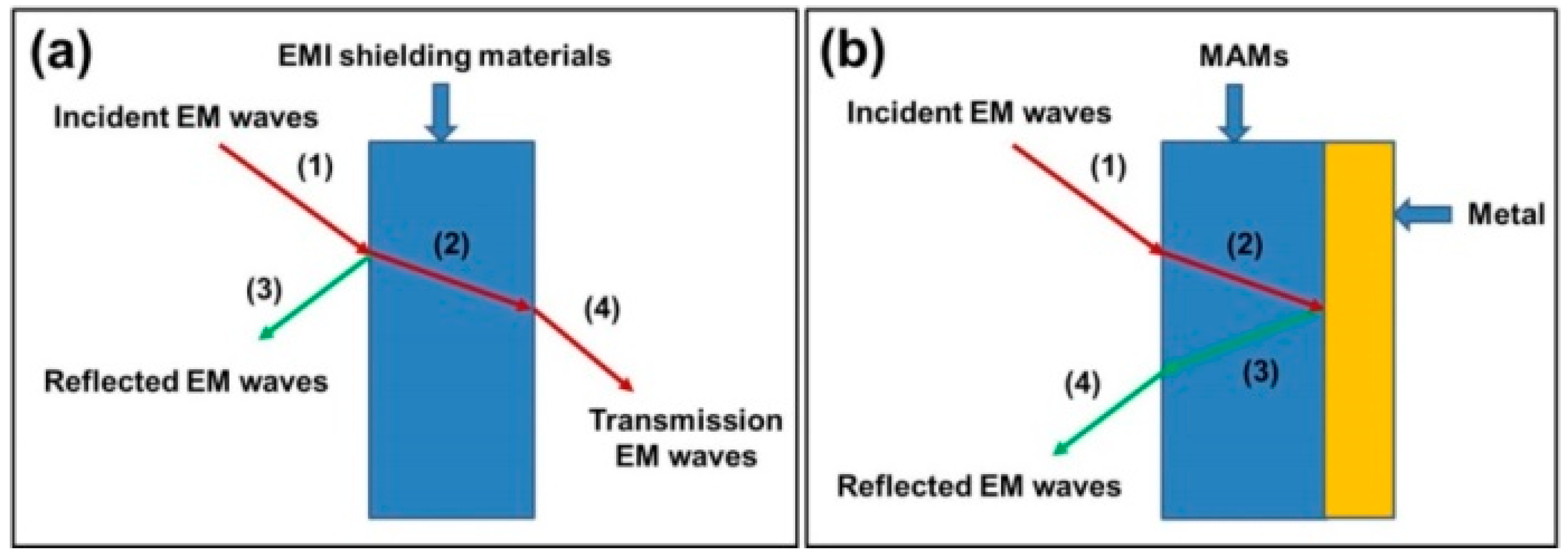

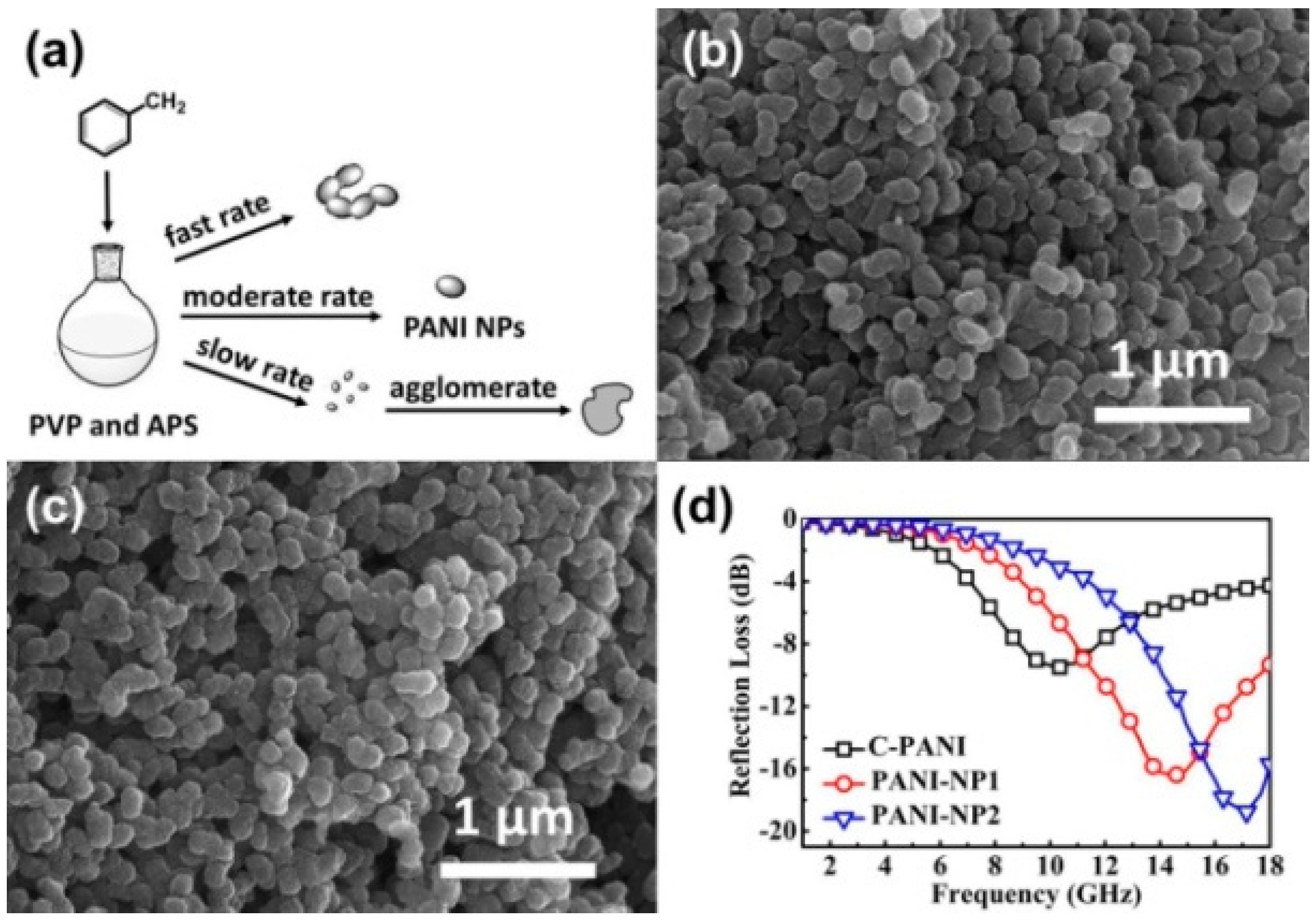


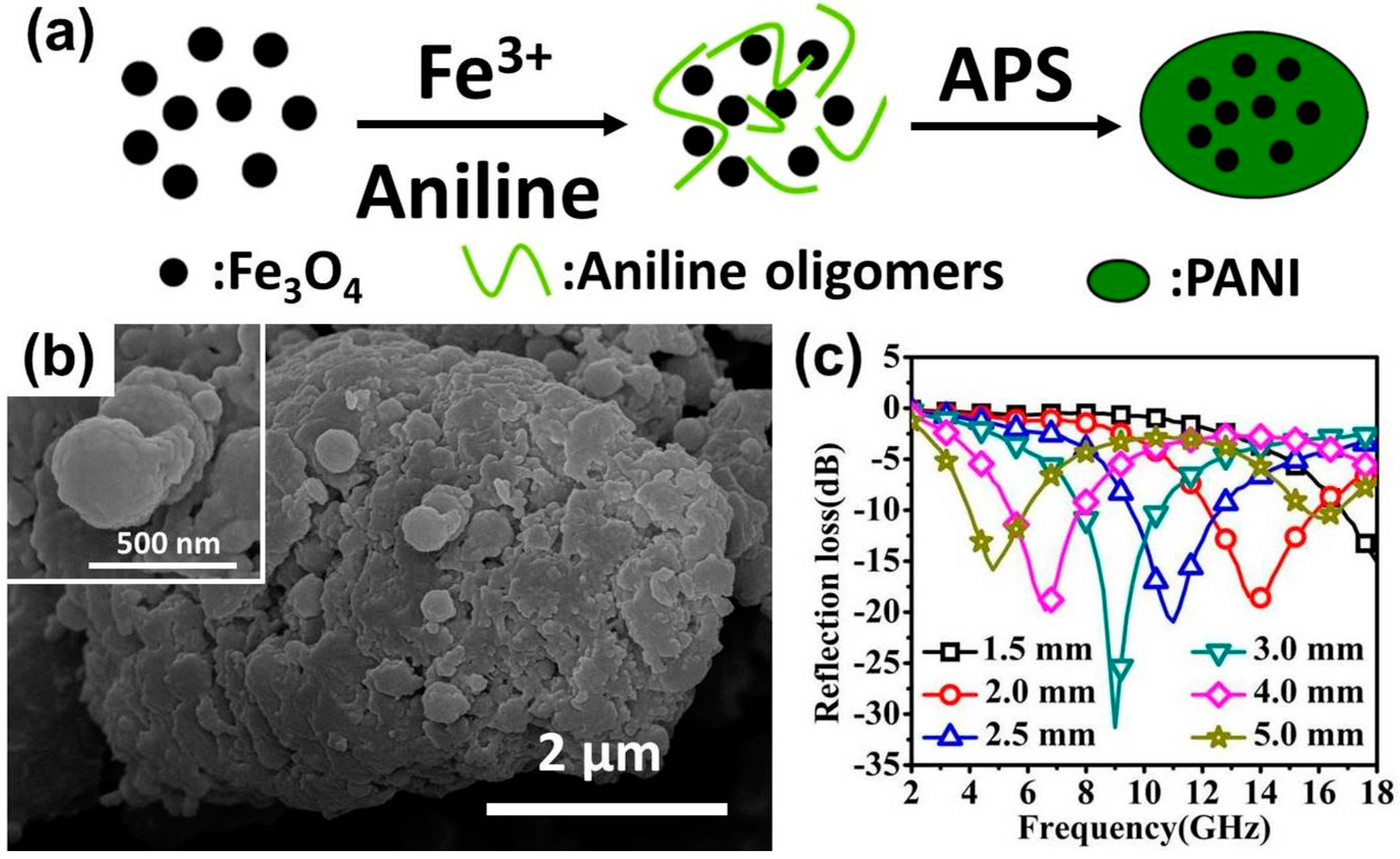
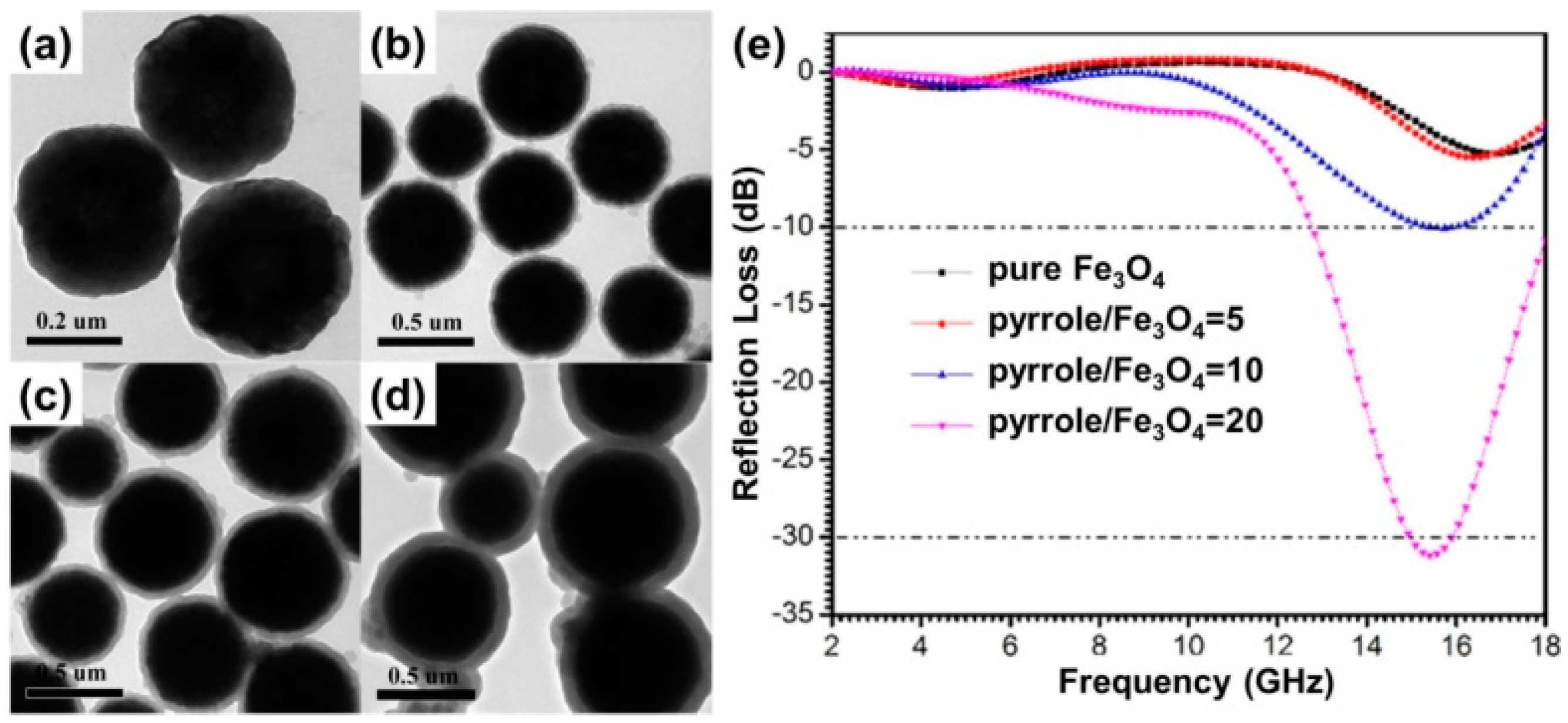




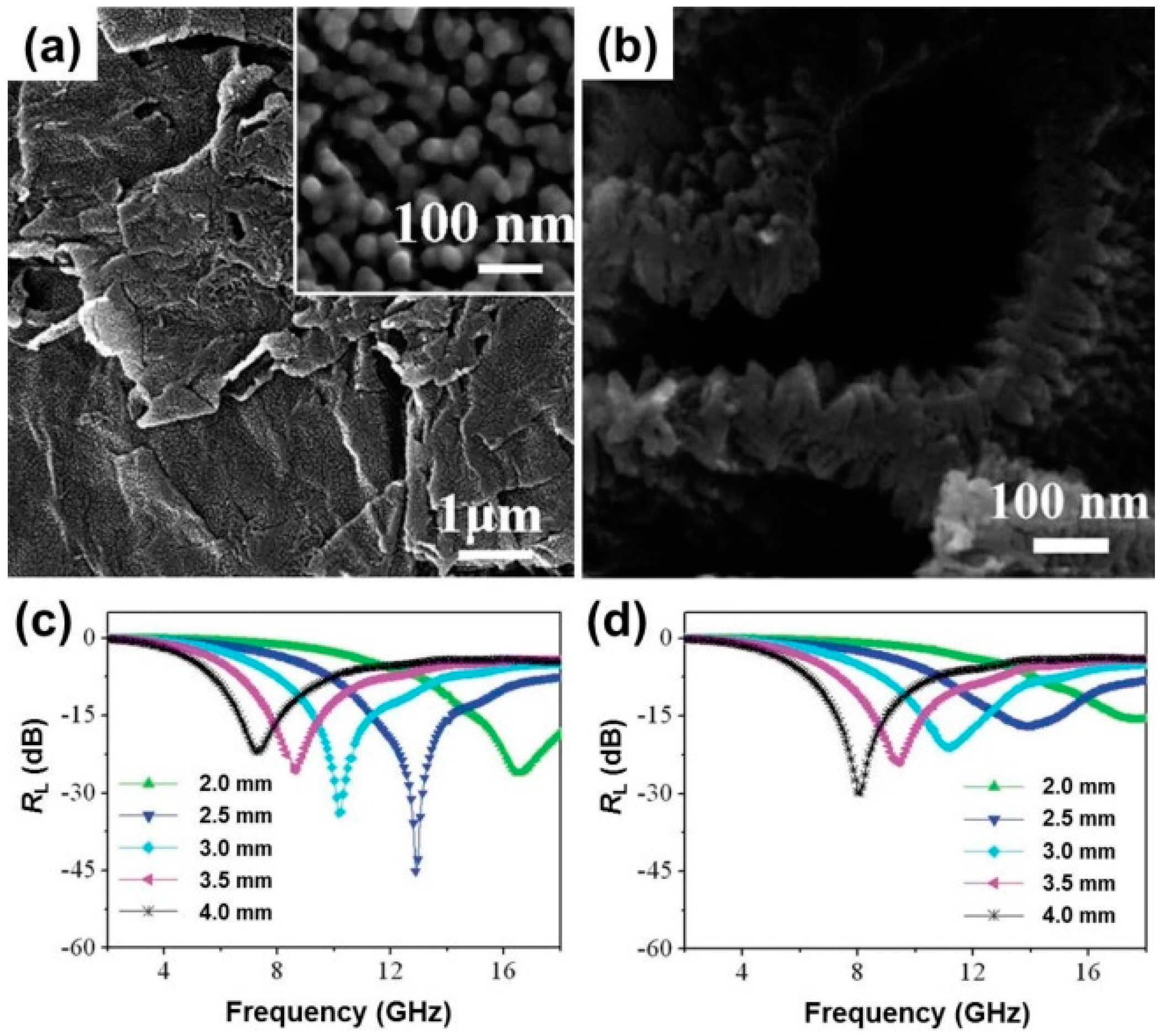
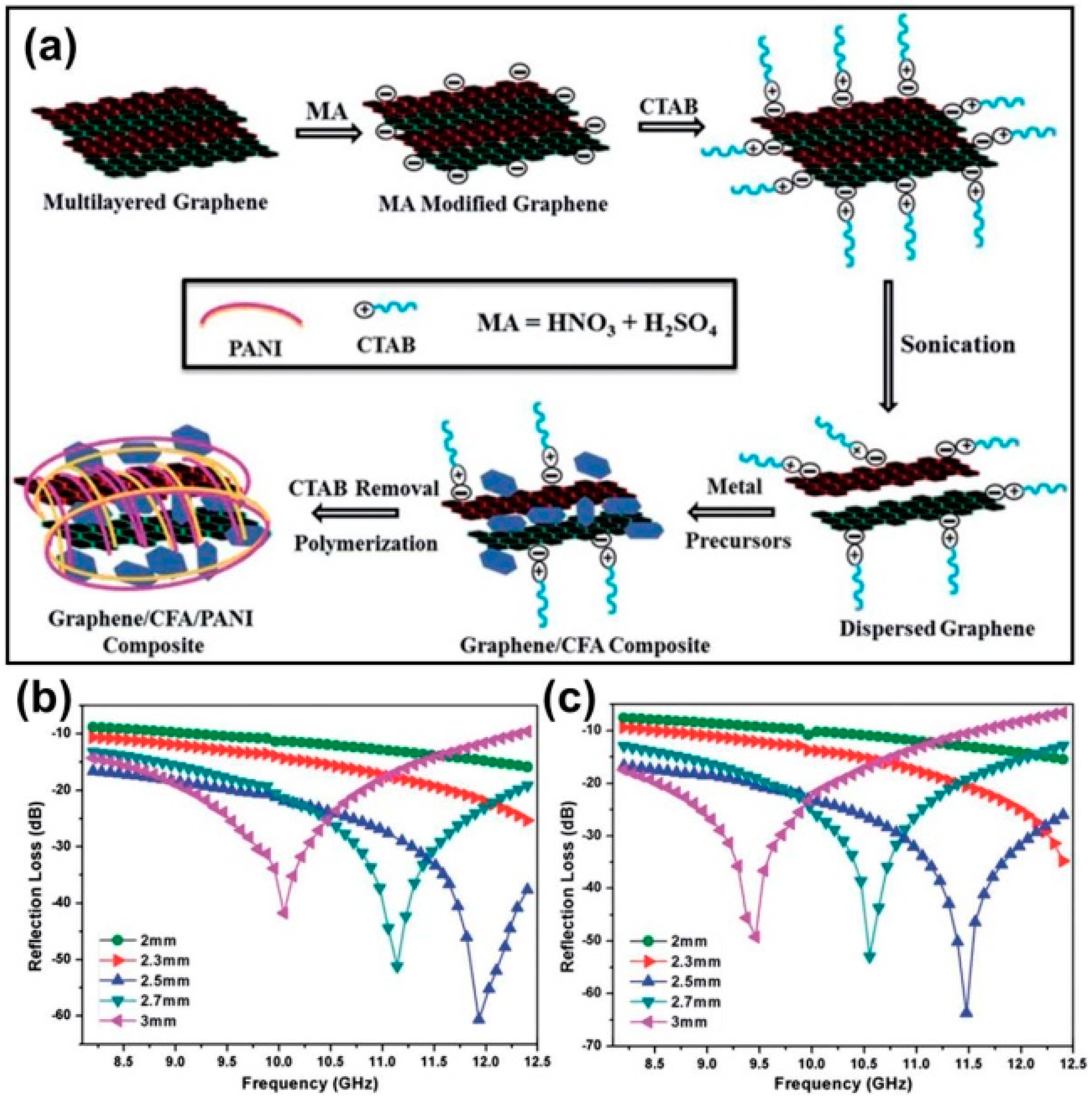
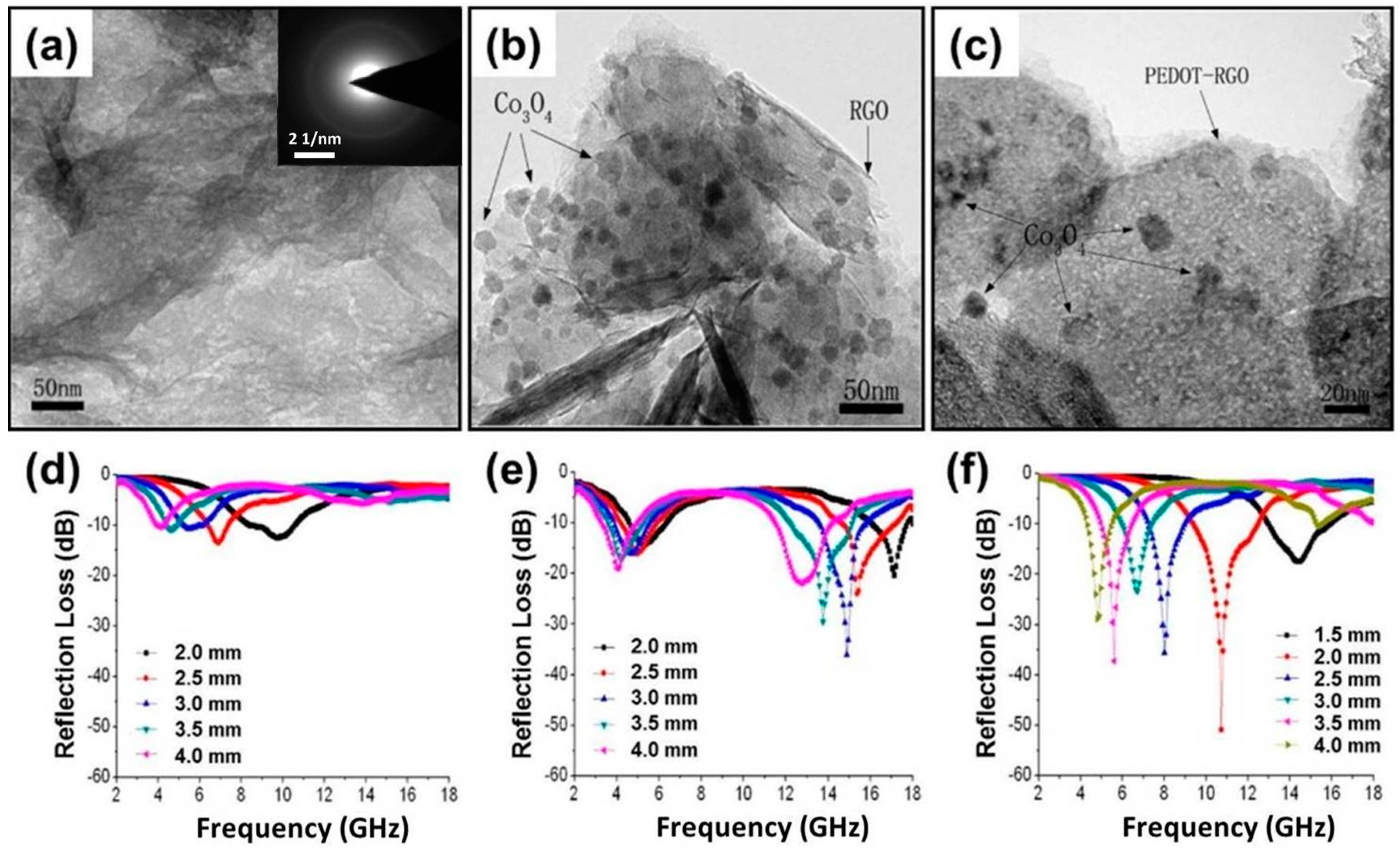
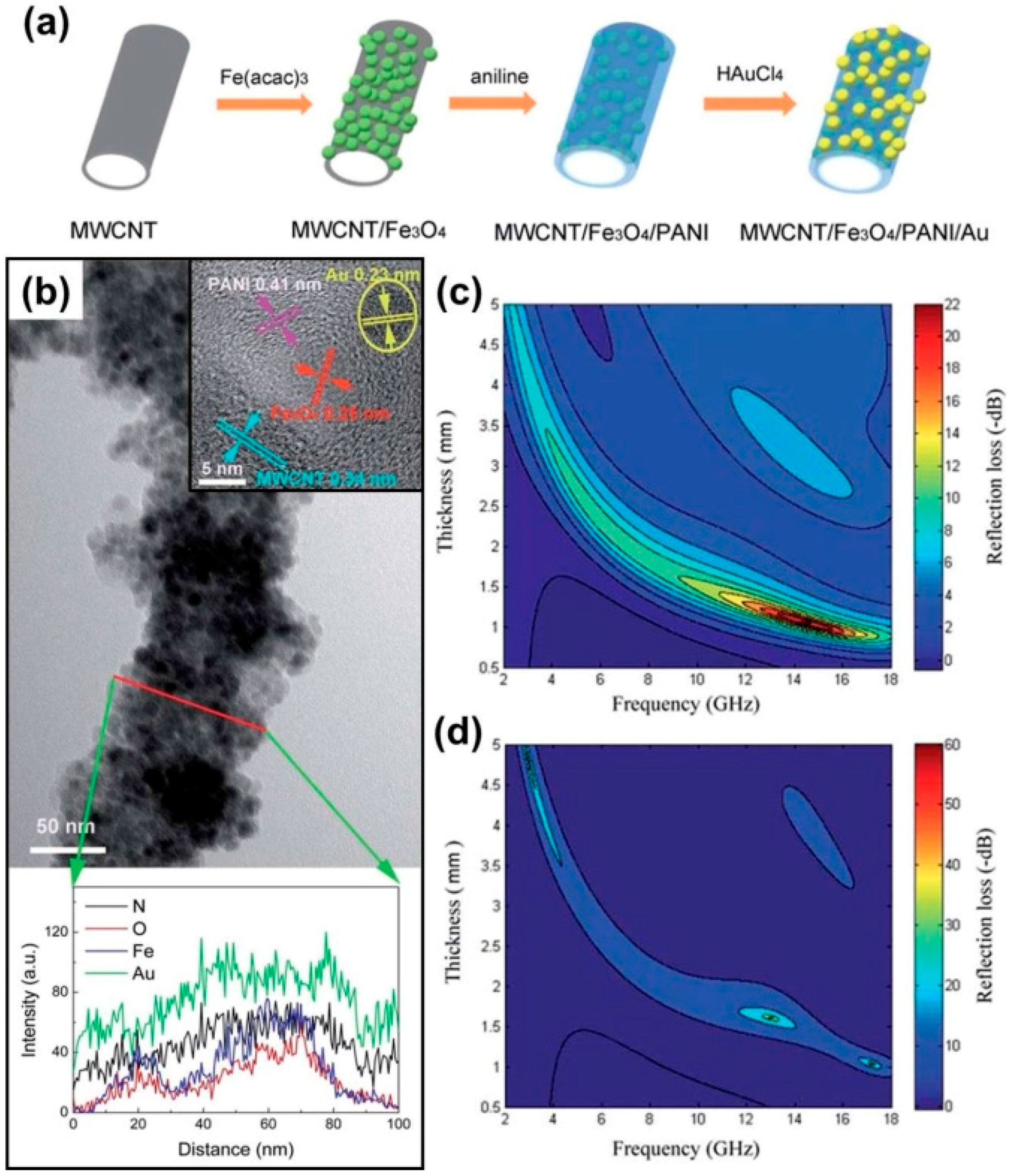
| Entry | Absorbers | Thickness (mm) | Maximum RL and Frequency | Bandwidth over −10 dB (Range, GHz) | Reference |
|---|---|---|---|---|---|
| 1 | 3D PPy aerogel | 3.0 | −22.5 dB at 12.0 GHz | 5.0 (10.0–15.0) | [60] |
| 2 | PANI nanoparticle | 2.0 | −18.8 dB at 17.2 GHz | 3.9 (14.1–18.0) | [62] |
| 3 | Fe3O4 nanoparticle/PPy | 1.7 | −35.1 dB at 16.7 GHz | 2.1 (15.9–18.0) | [79] |
| 4 | Fe3O4 microspheres/PANI | 3.0 | −31.3 dB at 9 GHz | 2.2 (7.6–9.8) | [86] |
| 5 | BaFe12O19/PANI | 2.0 | −20.0 dB at 14.5 GHz | 4.0 (12.8–16.8) | [95] |
| 6 | Ni/PANI | 1.0 | −23.0 dB at 17.8 GHz | 2.5 (15.5–18.0) | [118] |
| 7 | α-MoO3/PANI | 2.0 | −34.0 dB at 16.8 GHz | 2.8 (15.2–18.0) | [122] |
| 8 | MCNT-COOH/PPy | 3.5 | −16.0 dB at 11.5 GHz | 4.5 (9.5–14.0) | [138] |
| 9 | Graphene/PANI | 2.5 | −45.1 dB at 12.9 GHz | 5.4 (10.6–16.0) | [140] |
| 10 | 0.9BaFe12O19/0.1Y3Fe5O12/PANI | 2.9 | −40.8 dB at 9.9 GHz | 5.5 (6.8–12.3) | [148] |
| 11 | Graphene/CuFe10Al2O19/PANI | 2.5 | −63.6 dB at 11.5 GHz | 4.5 (8.0–12.5) | [160] |
| 12 | NiFe2O4/graphene/PEDOT | 2.5 | −50.5 dB at 12.5 GHz | 5.3 (11.0–16.3) | [168] |
| 13 | Graphene/Fe3O4/SiO2/PANI | 2.5 | −40.7 dB at 12.5 GHz | 5.8 (10.5–16.3) | [176] |
| 14 | Fe3O4-PANI layer/PANI layer | 1.0 | −42.0 dB at 29.27 GHz | 11.8 (25.5–37.3) | [186] |
© 2017 by the authors. Licensee MDPI, Basel, Switzerland. This article is an open access article distributed under the terms and conditions of the Creative Commons Attribution (CC-BY) license ( http://creativecommons.org/licenses/by/4.0/).
Share and Cite
Wang, Y.; Du, Y.; Xu, P.; Qiang, R.; Han, X. Recent Advances in Conjugated Polymer-Based Microwave Absorbing Materials. Polymers 2017, 9, 29. https://doi.org/10.3390/polym9010029
Wang Y, Du Y, Xu P, Qiang R, Han X. Recent Advances in Conjugated Polymer-Based Microwave Absorbing Materials. Polymers. 2017; 9(1):29. https://doi.org/10.3390/polym9010029
Chicago/Turabian StyleWang, Ying, Yunchen Du, Ping Xu, Rong Qiang, and Xijiang Han. 2017. "Recent Advances in Conjugated Polymer-Based Microwave Absorbing Materials" Polymers 9, no. 1: 29. https://doi.org/10.3390/polym9010029







